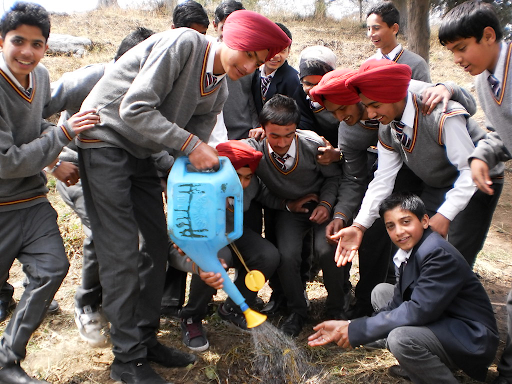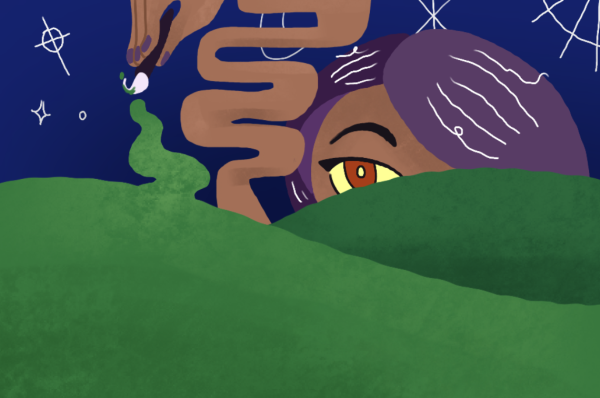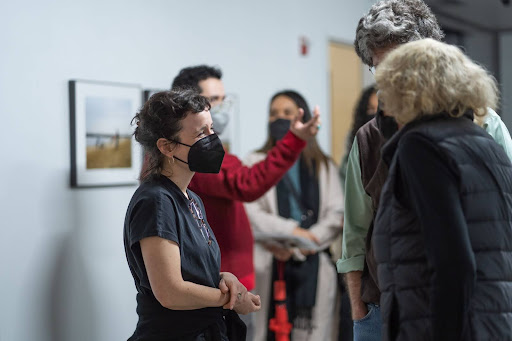“The Women’s War in Mali” art gallery exhibit empowers women
December 15, 2017
A graceful woman drives her motorcycle over the Niger River in Bamako. A bright pink purse sits in her hand, and her hair flows in the wind.
Several girls compete on a basketball court in Timbuktu, each eager to grab the basketball from the other, their faces bright yet fierce.
Renowned photojournalist Katie Orlinsky shared these snapshots and more of women in Mali in the PDS Anne Reid ‘72 art gallery exhibit “A Quiet Defiance: The Women’s War in Mali” from November 20 to December 14. Despite the restrictions put on the women by jihadist militants during the jihadists’ control of Mali from 2012-2013, the women of Mali fought back by continuing to do the things they love.
AP Art History teacher Elizabeth Monroe saw Ms. Orlinsky’s work as an opportunity to “highlight contemporary issues in Africa, highlight the way that world religions have changed and changed the people who live under them and practice them, and also now to collaborate with a variety of student groups.” Dr. Monroe said that this exhibit focuses on “a contemporary issue not just in Africa, but one that affects us globally.” She added, “I feel an incredible connection to these women halfway around the globe, who are so incredibly courageous and brave.”
To publicize this inspiring exhibit in the PDS community, history teacher Sam Hunt, French Club, and Gallery Club collaborated on a presentation about West Africa for the Upper School during US Gathering on December 5.
During her visit to PDS on November 28, Ms. Orlinsky interacted with students at her exhibit’s lunch opening and visited several classes, including the English elective “Wild Inside, Wild Outside,” telling them about her exhibit as well as her journey through photography. Senior Kyra Hall, a student of the English class Ms. Orlinsky visited, described that Ms. Orlinsky “works really hard to combine activism and photography.” After graduating from Colorado College, Ms. Orlinsky traveled to Wahaka, Mexico to begin her photography career. While she was there, there was a conflict outbreak, and this hooked her in terms of her work. Ms. Orlinsky’s experience in Wahaka showed her the importance of authenticity and storytelling through her photos.
In addition, Hall described how Ms. Orlinksy always asks if she can take photos of the people because “for her, it’s more about getting to know the person, and getting to know their story, and getting their story out there, than it is about the photo.” As junior Angela Talusan said, Ms. Orlinsky’s work is not just a collection of war photos; “she is photographing women … defying that suffering.”
In photography, “all the aspects of the photo, like the color, and the vantage point, and the shadows, and the light come together to create this mood that is like for many of the photos often more powerful than the photo itself,” junior Nina Ajemian asserted. Senior Mary Schafer said that Ms. Orlinsky’s photos are “visually striking on their own, even without any context.” Schafer added, “I personally appreciate that we have this gallery, because it’s also clarified for me what’s actually going on, and now I actually have background knowledge.”
Ms. Orlinsky’s exhibit is also meaningful as it empowers women. “My dream is, in the near future, for women’s issues to just be issues,” Hall said. “[Ms. Orlinsky] said that that is a huge interest of hers because she thinks that it’s something that’s not talked about, not addressed enough.” In her exhibit on Mali, Ms. Orlinsky not only accomplished this, but also showed the strength of women in the face of challenges.

















